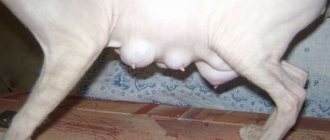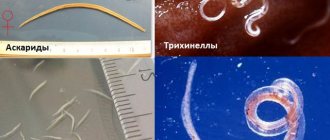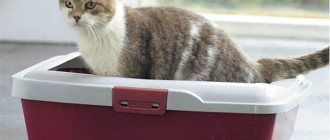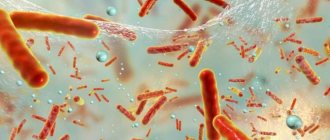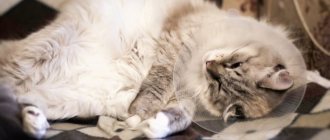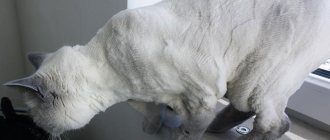Eggs hatch larvae that spin cocoons
and develop into pupae and then develop into adults. Depending on environmental conditions such as temperature, humidity and the presence or absence of hosts, the cycle can take anywhere from several weeks to several months.
Cat flea larvae hatch from eggs that an adult female flea lays on its host, the cat. They do not remain on the body, but fall off when the cat moves. The animal stands up, stretches and shakes itself, and the flea eggs simply fly off into the environment.
Flea eggs look like translucent oval dots about 0.5 mm long. But it is quite difficult to see them, since they dry out quickly after being deposited
, become heavy and fall out of the cat’s fur. The best place to look for flea eggs is in your cat's bedding and other places where your cat likes to sleep. If the cat is heavily infected, you can look with a magnifying glass at the base of the tail or on the stomach. If there is flea dirt in your cat's bedding, it likely contains flea eggs. Flea dirt is dark and the eggs in it have a whitish appearance.
Even experienced cat owners cannot always boast of an excellent knowledge of all the ailments that can happen to a pet. What can we say, only a veterinarian can know everything. Careful owners can only pay attention to their furry pet in a timely manner and not leave seemingly minor changes unattended.
White grains (microscopic balls)
White specks on cats' fur can only be noticed upon careful inspection.
One of the strange manifestations of cat malaise is white grains or microscopic balls that fall off the animal’s fur. They are not noticed immediately. At first, they only evoke puzzled glances from the owner and a silent question in his eyes. Where do the mysterious grains come from and what are they?
White grains are nothing more than flea eggs that have not yet hatched. They can get on the animal's skin and, accordingly, on the fur.
What to do and how to detect
If you notice a change in your pet's behavior, carefully examine him to see if he is bothered by fleas.
First of all, you shouldn't panic. In order not to bring the situation to critical limits, it is necessary to monitor the cat more often. This advice may seem very uninteresting and philistine, but this is the only way to notice changes in the health of your pet.
It is necessary to inspect your pet and the places where he recently sat more often.
Flea eggs in the form of white grains will be especially noticeable on dark surfaces.
Having discovered uninvited guests, it is important to begin eliminating them as quickly as possible.
Symptoms
If black specks appear on a cat's skin, the pet owner should check for other symptoms of the disease. For example, a cat may suffer:
- baldness;
- swelling of the body;
- redness of the skin;
- small pimples that increase in size and number over time.
Pay attention to your pet's behavior. The appearance of black dots on a cat’s body is often accompanied by itching, due to which the animal becomes restless and constantly itches. Only an experienced veterinarian can make an accurate diagnosis after conducting the necessary research work.
The black dots that appear under the cat's fur are most likely skin plugs clogged with excess sebum, or a manifestation of an internal disease.
Getting rid of the source of white grains
Bathe your cat only with special shampoos.
- Next, you need to treat the cat with flea drops
, which are applied to the withers.
Flea drops for cats are very effective.
- The next step should be a flea collar
.
Thanks to special impregnation, the collar repels fleas.
Many limit themselves to drops and ignore collars. Meanwhile, they represent a very powerful defense option. A classic flea collar is impregnated with a special substance that repels fleas.
The action continues for 6 months.
Grains, i.e. Flea eggs appear after adult fleas have settled on the body; they lay their offspring.
Consolidate the result
You should pay attention not only to your pet’s hygiene, but also to the cleanliness of its bed or house.
After treating the cat, you should take care of the living space.
There are probably eggs left in the apartment that have fallen from the cat’s fur. They can lie unnoticed for a long time until adults hatch from them.
All carpets, mattresses, soft furnishings and bedding should be thoroughly washed and vacuumed.
This point should not be missed, otherwise all the cat’s treatment will be in vain.
In addition to the actions taken, a visit to the doctor would be useful.
He will examine the animal's body and may find painful scratches on the skin from flea bites. You can do this yourself. But the specialist will give all the necessary recommendations.
Preventive measures
It is important to take action at the slightest suspicion of fleas in a cat.
And of course, it is necessary to have your cat examined at least several times a month.
The fur needs to be spread apart so that the skin is visible. A healthy purr is always clean.
Solution
Therapy against parasites consists of several stages:
- Bathing a cat with special shampoos. This step is mandatory. Recommendations on the choice of product can be given by a veterinarian.
- Treating the animal with flea drops, usually applied to the withers.
- Wearing a collar. Its task is to repel parasites. The collar lasts on average up to six months.
- The remaining eggs or adults should be destroyed, for which the animal’s sleeping place is sprayed with anti-parasite sprays, and the bedding is washed.
- Carry out a general cleaning of the house, thoroughly shake out sand from carpets, vacuum mattresses and curtains, and, if possible, wash them.
Return to contents
conclusions
A responsible owner always takes a short course of veterinary lectures without attending classes. Knowledge comes with experience caring for a pet. This is good, because an owner savvy with skills and theory will always be able to help a defenseless animal in a timely manner.
If you find black grains similar to earth on the chin or near the lips of your tailed pet, you should not console yourself that he, like a mole, digs the earth and it is just dirt. Felines are very clean animals and do not allow such an abundance of dirt on their bodies.
But at the same time, there is no need to panic. Most likely, the disease is akin to human acne and acne. It seems like a small thing, but it’s ugly and unpleasant.
Viral infections
Diseases caused by a virus are rare, but still occur. This could be leukemia, immunodeficiency, herpes. In this case, in addition to skin damage, as a rule, there is a violation of the integrity of the mucous membranes and the involvement of internal organs in the pathological process.
Pathology can often be determined from a photo. For example, herpes has characteristic rashes, and calicivirus is manifested by damage to the paw pads, which is clearly visible in the photo. They all need to be treated, and throughout their lives. The main focus is improving immunity.
Loading …
Even experienced cat owners cannot always boast of an excellent knowledge of all the ailments that can happen to a pet. What can we say, only a veterinarian can know everything. Careful owners can only pay attention to their furry pet in a timely manner and not leave seemingly minor changes unattended.
Causes of black specks on the chin
The appearance of black specks on the chin of each cat is purely individual.
There are no specific causes of acne in cats, just like acne in humans.
This unpleasant phenomenon can be caused by an infinite number of factors that are individual for each organism.
Greasy chin
Black specks on wool
Veterinarians call this phenomenon “greasy chin.”
, since it is caused by blockage of the sebaceous glands, as a result of which comedones appear, which look like grains of earth. Under no circumstances should you comb them out, squeeze them out, or try to remove them in any other way. This may not be a terrible disease, but it is still a disease that can affect animals of any age and breed.
All domestic cats are prone to acne. Stray and yard cats and kittens very rarely get it.
Preventing cat acne
For preventive purposes, in order to prevent black spots from appearing in a cat’s fur, it is advisable to feed the animal from a ceramic, glass or iron bowl. It is better to refuse plastic utensils. It is also worth making sure that the cat always has clean water. It needs to be changed at least once a day.
If your cat is overweight, reconsider his diet. Food should be enriched with microelements and vitamins. Take care of your pet and then black spots in the fur will not bother you or him.
Vet
If you have a strong desire to give your mustachioed friend fresh air, there are carriers for this. You can put your cat in it and safely walk with it outside. All other methods are fraught with danger to the health of the animal.
Causes of black specks
The cause of acne can be as simple as insufficient care
. The chin is a difficult place to lick.
One of the causes of acne is a dirty chin.
Poor quality nutrition may also be a cause. You should not buy food in bulk, its quality is quite controversial. Cheap food can also cause changes in the functioning of the sebaceous glands, which begin to produce a lot of subcutaneous fat.
And also such a basic thing as a plastic plate
, from which the pet feeds can cause a problem. Plastic absorbs all microbes that are not washed away, but develop.
But there are possible and more serious reasons that are not so easy to remove. This may be a decrease in the body’s immune defense, various anomalies in the development of glands, and even stress suffered by the pet.
Preventive measures
Treating a cat
Garden treatment:
- pseudotuberculosis is an acute infectious disease that, despite the name, has nothing to do with pulmonary tuberculosis;
- tularemia is a bacterial infection that affects the lymph nodes;
- brucellosis is an infection that affects multiple organs and systems of the human body;
- dipylidia – infection with tapeworms.
In addition, it can cause allergic dermatitis; the itching at the bite sites is quite strong and lasts for several days, during which a person is able to scratch the bite site until it bleeds, which, in turn, can lead to infection directly into the wound.
How to get rid of black specks?
At the first symptoms of acne, consult a doctor!
Some animals have been sick once, and the owners can forget about this problem: they changed the food, changed the bowl, wiped it under the chin, especially for well-fed cats.
If the reasons are deeper than just everyday ones, then acne can appear again and again.
If you notice the symptoms in time, and this is redness of the skin and slight swelling, then this trouble can be quickly stopped by yourself. If pustules appear, you should see a doctor to avoid other similar diseases.
Acne treatment
Vitamins should be introduced into the cat's diet.
At the initial stage, i.e. redness and the appearance of small pimples, lubricate with salicylic alcohol and add vitamins to food. True, salicylic alcohol has an intolerable odor that cats do not tolerate well.
Acne is cured well when using chlorhexidine. This drug is applied to the affected area, then dried and lubricated with iodine. You need to be careful with iodine so as not to burn your skin.
We recommend tar soap or shampoo, which have a drying effect.
Cucumber lotion can also help, but only in the primary stage of the disease. When the sebaceous glands dry out, the unpleasant grains dry out and fall off on their own. From the long hair of the animal, in which the fallen grains are hanging, they can be carefully combed out. Your pet will have to go on a diet that excludes all fatty foods. It is useful to change food and switch to expensive food, at least for the duration of treatment.
Don't delay contacting the veterinarian!
If within a week the treatment has not brought tangible results, i.e. the number of comedones has not decreased, but even increased, you should see a doctor. Consequently, the problem is not only cosmetic, but also the physiological state of the animal. After examination, scrapings and ruling out all other diseases, the doctor will prescribe a systemic course of treatment.
Fleas survive by jumping on a host animal, burrowing into its skin and feeding on blood. In most cases they cause only mild itching, but in severe infestations, especially in kittens or older sick cats, they can cause severe anemia or even death of the cat. Fleas are also intermediate hosts of helminths. Some cats are hypersensitive to flea saliva. This causes severe itching and a local or general skin reaction.
A flea infestation can be identified by finding fleas on your cat or by seeing black and white flecks in the cat's fur, similar to grains of salt and pepper. These particles are flea feces (“pepper”) and their eggs (“salt”). Feces are formed from digested blood. If you comb them onto damp paper, they turn reddish-brown.
An adult flea is a small, dark brown insect, about 2.5 millimeters in size, that can be seen with the naked eye. Although fleas do not have wings and cannot fly, they have powerful hind legs that can be used to jump long distances. Fleas move quickly in fur and are difficult to catch.
Look for fleas on the cat's back and in the tail and back of the body. To do this, run a fine-toothed comb through the fur. Sometimes fleas are visible in the groin area, where it is warm and there is less fur. Itching is most severe in these areas.
New methods of flea control
New products such as Program, Advantage, and Frontline have virtually replaced the use of solutions, powders, aerosols, and shampoos in the treatment and prevention of fleas. New drugs are more effective and safe than traditional insecticides. They are also easier to apply.
Program (trade name lufenuron) was the first and remains one of the most popular drugs for flea control in cats. Program is a tablet or liquid given once a month with food. The drug is also available in the form of injections, which are administered every six months.
The active ingredient accumulates in the cat's subcutaneous tissue and acts when the flea bites the cat. Program inhibits the growth of eggs and the hatching of fleas. This results in a sustainable reduction in the number of new fleas in the environment. Its effect is limited to the hard outer shell of the flea; the drug is absolutely harmless to mammals. However, since the drug does not work on adult fleas, it may take 30 to 60 days or more before the adult fleas die of age and you notice a decrease in itching and scratching. All animals in the house must be treated with Program for the treatment to be effective.
Advantage (imidacloprid) is a topical liquid product that kills fleas on direct contact and is taken once a month.
After application, 98 - 100% of adult fleas die within 12 hours. Therefore, any new fleas that infest the cat must die before they have a chance to lay eggs. This breaks the fleas' life cycle and ultimately kills all fleas in the environment. Advantage is not absorbed by the cat's body and is therefore non-toxic. Humans do not absorb this chemical when interacting with a medicated cat. Advantage can be used to treat kittens from 8 weeks of age.
Frontline and Frontline Spray contain the active ingredient fipronil, which kills fleas on contact within 24 to 48 hours. The flea does not have to bite the cat for the drug to work. Frontline is a topical liquid medication in tubes used in the same way as Advantage.
Frontline Plus contains S-methoprene, which kills adult fleas, eggs and larvae. It also treats lice and is used as part of a treatment program for scabies. Frontline Plus is intended for kittens 8 weeks and older.
Revolution (Selamectin), a heartworm preventative, is a topical liquid applied once a month to the skin of your cat's neck between the shoulder blades, just like Advantage. It also treats adult fleas and prevents flea eggs from hatching. Selamectin may also be used to treat ear mites, roundworms and hookworms, and some mites.
One flea will not drink much blood and traces of its presence are almost impossible to detect, but it is capable of leaving numerous offspring, which over time will cause a lot of trouble not only for the animal, but also for its owner.
Features of cat therapy
It is important to remember that many of the proposed insecticidal preparations are effective against adults, but are harmless for eggs, larvae and pupae. A flea comb does not allow you to comb out all the parasites. A complex treatment of fleas is used using oral medications, for example, Program. It is given to the cat once a month. Once in the flea's body with the blood, it prevents the eggs from hatching. The choice of pharmaceutical drug should be entrusted to a veterinarian, especially if the female is pregnant. In addition, each medicine is designed for a specific type of parasite. Dog drops will not be effective against cat fleas; they still remain in the fur.
Animal diseases » Cats »
Cats are sensitive creatures. Any change in the nature of nutrition, care and living conditions can negatively affect their condition. Most often, skin diseases appear. They can be caused by infection, bacteria, parasites and insects. In addition, there are a large number of congenital pathologies in which cats develop problems with the skin.
All changes on the skin refer to the unifying term - dermatitis. In this case, itching, flaking, changes in behavior in cats, as well as deterioration in their appearance may be observed. But still, the main symptoms and treatment directly depend only on what exactly caused the pathology, that is, on their cause.
Flea - appearance, structure, symptoms
Fleas are found everywhere. This is a fairly large order of insects, which includes subspecies that feed on cat, dog, rat and even human blood. They differ from each other in size, color of the chitinous cover and some features of the body structure.
What does a cat flea look like?
The cat flea is one of the most common and small species among the flea order. The size of an adult insect rarely exceeds 3 mm. For comparison, fleas that feed on human blood have body sizes of up to 5 mm, and moose fleas often reach a length of 12 cm! They move quite quickly on the animal’s body, as they are perfectly adapted for movement in thick fur. They have a body that is flattened laterally, allowing them to maneuver between hairs, and long hind legs, with the help of which fleas are able to make jumps up to half a meter long.
The color of a cat flea can vary from light red to dark brown. Sometimes there are almost black insects that are practically invisible in the fur of an animal with a dark color. Upon closer examination, one can discern light stripes on the abdomen that form at the joints of the abdomen. They become most noticeable when the insect is saturated, when its body increases in size.
What does a flea look like on a cat's body? Outwardly, they look like large grains of dirt stuck in the fur, and only at the moment of their movement it becomes clear that these are insects. A lot of deception is facilitated by flea excrement remaining on the skin of the animal, which is sometimes mistaken for insect eggs.
Flea larvae are not at all similar to adult insects. Outwardly, they look like legless and eyeless dark-colored worms with sparse bristles on the segments of their body. They are very small, no more than 6 mm in length and 1-2 mm in thickness. Unlike adult fleas, larvae do not feed on blood and live outside the animal’s body, in the folds of upholstery of upholstered furniture, carpet pile, and cracks in ceilings.
Flea eggs are small, white, about 0.5 mm long. Females lay them on the floor of the room, where they further develop to the larval stage. Flea eggs look like grains of semolina stuck to your finger:
Interesting fact! Fleas do not live on animals permanently. They only feed on their blood, but live on the floor of the room, in all sorts of cracks and in the upholstery of furniture.
Body structure
If you look at a flea from a close distance, you can see that its entire body is covered with numerous bristles and spines. They help the insect stay on the animal's body. The bristles are located over the entire surface of the body, on the limbs, back, and head. At the ends of the legs, 2 claws are also clearly visible; with their help, the flea moves in the thick undercoat. The hind legs are well developed and consist of 5 segments. The forelimbs are somewhat shorter, they do not participate in jumping and are mainly adapted for moving along the animal’s fur.
Female fleas are usually somewhat larger than males due to their voluminous abdomen, where they carry their eggs for the time being. In the back of the body in both sexes there is a peculiar tactile organ equipped with sensitive hairs.
Symptoms of fleas
- on the back;
- near the ears;
- in the armpit;
- on the skin in the chest and cervical area of the body.
Cats can seriously damage their skin when trying to get rid of insects.
Microbes get into the wounds, which in some cases leads to inflammation of the skin and the development of all kinds of dermatitis. If you suspect that there are fleas in the house, first check the animal's skin. As a rule, insect waste products can be found on it - black lumps of digested blood. When rubbed between your fingers, they break up into small particles. There are usually quite a lot of such traces left in the thick undercoat. In shorter and less dense hair there are fewer of them, since they are combed by the animal onto the floor, where they become food for flea larvae.
Interesting fact! After saturation, fleas jump off the animal and hide in floor cracks or other hard-to-reach places. The next “feeding” occurs no earlier than in a day.
What do flea larvae look like and where to look for them in the house?
Fleas, like many other types of insects, undergo a complete transformation in their development. Actually, that’s what they’re called: insects with a full cycle of transformation. This means that the eggs laid by the female flea hatch into larvae that are very different from adult fleas in both their appearance and lifestyle.
This type of development provides certain advantages for insects: flea larvae and adults do not compete with each other for food sources and habitats, and, accordingly, at each stage of development, parasites have a greater chance of survival.
However, for those who are trying to fight fleas, for example, in an apartment or house, this type of development of parasites creates certain difficulties: in some cases, it is necessary to destroy the larvae using additional means and measures. But first of all, you still need to be able to detect them in order to know which places to treat with insecticides.
Larvae
Flea larvae look like tiny white worms with a translucent body. Even if you look carefully, you cannot see their legs - they simply don’t exist. But the body of the larva is covered with sparse hairs, clearly visible under a magnifying glass or microscope. In her body, the esophagus is clearly visible, filled with digestible food - various organic residues. The maximum length of flea larvae that can be found in residential premises is 4-5 mm, the usual length is 2-3 mm. They can easily be confused with fly larvae that live in similar places, but the maggot is more mobile and does not have such transparent body coverings.
The flea larva has a fairly large head and 13 segments. Evolutionarily, the first three segments served to attach the legs, but gradually the limbs atrophied as unnecessary. Flea larvae have well-developed jaws of the scraping-gnawing type, allowing them to feed on fairly rough food.
Regardless of whether the flea infests cats, dogs or rats (cat, dog and rat fleas), the insect larvae look almost the same.
Therefore, when you find flea larvae in cats on the bedding or in a resting place, you can never be sure which species they belong to.
And there is no particular need for this - all these species have a similar lifestyle, and they should be dealt with using the same methods.
Lifestyle and nutrition of future parasites
- Generally speaking, flea larvae are not parasites. Their food consists of various decaying organic matter, from plant remains to the excrement of adult fleas, which contain the undigested blood of the victim. The larvae themselves do not bite either animals or humans.
- The development of the larva continues, depending on the availability of food and temperature conditions, from 9 days to several months.
- Under optimal conditions - a temperature of about 23°C and an air humidity of 60%, the larvae develop in approximately three weeks. During this time, they molt three times, constantly grow and feed. At the last stage, the larva envelops itself in a thin silk cocoon and turns into a pupa.
- At too high temperatures, flea larvae dry out - at low humidity this occurs already at 34-36°C. At high air humidity (up to 90%), growing juveniles experience this temperature quite normally.
- Flea larvae can starve for quite a long time - up to 3-4 weeks. At the same time, they do not develop, do not grow, but also do not fall into suspended animation. The larvae have developed the so-called negative phototaxis - wherever they find themselves, they try to get into the least illuminated place. Although the eyes of flea larvae are practically undeveloped, they sense the presence of light well and try to hide from the illuminated place.
Where to look for larvae?
Flea larvae usually stay where they have direct access to food and can be found in comfortable climatic conditions - in garbage, secluded warm places, in animal cages - in the toilet and under beds. In nature - in the nests and burrows of mammals and birds.
In apartments and houses, flea larvae should be looked for primarily in places where cats, dogs and other pets live and are kept, in heaps of garbage in pantries and closets, among stocks of old grocery products.
In garden plots, chicken coops and animal keeping areas, flea larvae live directly in the litter and dried droppings. It is under the layer of garbage and droppings in the same chicken coop that flea larvae sometimes swarm literally in the thousands.
However, you can also find flea larvae in completely unexpected places - in vases with flowers, under trash cans, in a box in which vegetables are stored. It is important to understand that they do not start here on their own, and you should look for them only when adult fleas were found in the apartment.
Means and methods of destruction
Flea larvae should be destroyed indoors using the same means that are used against adult fleas:
- these can be as concentrates for dilution such as Executioner, Cucarachi or Tetrix, Raptor or Combat aerosols;
- as well as microencapsulated products such as Dana or Get (the latter has almost no odor);
- and even folk remedies - turpentine, kerosene, vinegar.
Traditional substances such as Dichlorvos or Karbofos are also effective against flea larvae, but in terms of safety and ease of use they are much inferior to modern drugs.
Dusts are also effective against flea larvae, but are practically useless against adult fleas. However, using powdered insecticides is somewhat more difficult, since they need to be scattered in places where the larvae are constantly located, which is sometimes problematic, and sometimes, when the larvae are found behind baseboards or under the floor, it is completely impossible.
In this case, it is very important that the dust itself is certainly near the larvae, since it only works when the pests eat it along with other food. Therefore, it turns out to be generally more difficult to deal with larvae than with adult fleas - even with aerosols, when fighting them, you need to treat places where it is very difficult to get close and where adult fleas themselves are not found.
There is no point in removing growing juvenile parasites with natural preparations that can only scare them away. For example, if the same wormwood or tansy can scare away adult parasites from a room, the larvae, even in the atmosphere of such herbs, will have nowhere to go, and they will simply get used to such repellents.
Flea larvae do not enter indoors on their own, on cats or dogs. They can appear here only from eggs laid by adult insects. Therefore, the only way to protect an apartment from flea larvae is to prevent adult biting parasites from entering the premises.
Causes of fleas
- while walking in contact with an infected animal;
- through household items that have insect eggs and larvae on their surface;
- when adult insects are brought into the house on clothes or their larvae with dirt on shoes;
- from neighboring apartments where there are infected animals.
Do cat fleas bite people? A hungry flea attacks anyone who is nearby. There are no special restrictions in her diet, although she still prefers the blood of animals, and of a certain species. There is evidence that fleas attack people in the absence of their pets. Single bites can also be observed when the apartment is heavily infested with insects.
Fleas from cats are not transmitted to humans in the literal sense of the word. Insects only feed on animals and, accordingly, will not live on humans. However, they can migrate from place to place by jumping onto a person's clothing. This can happen if he walks near their habitat or pets an outdoor cat. Fleas can also move into the folds of clothing if a person picks up care items for an animal infested with insects.
Advice! To protect yourself from flea attacks, you need to carefully monitor the sanitary situation in your apartment - periodically wash the floor, wipe off dust, and wash dirty linen. It is in dust and piles of garbage that insects live and their larvae develop.
Fighting methods
Animal processing
- shampoos
- sprays
- drops
- collars
- pills.
Anti-flea shampoos that contain an insecticide have proven themselves to be excellent. With their help, you can get rid of insects on an animal in one go. They are relatively safe for cats and last quite a long time after treatment. However, shampoos are not always convenient to use, especially if your pet is afraid of water. In this case, you can use flea spray.
Insecticidal preparations in the form of a spray are applied to the surface of the cat's skin, and certain protective measures must be taken to protect both the animal and the person carrying out the treatment. The face is covered with a gauze mask, and gloves are put on the hands. It is best to wear a special collar on your pet, designed to prevent the animal from licking the drug from its fur. You also need to cover the cat's eyes, nose and mouth.
Flea drops are applied to the animal's withers. This is perhaps one of the easiest to use products and is most popular among cat owners. It effectively rids the animal of fleas and at the same time is practically safe for the animal, since the toxic substance is applied to an area of the body inaccessible to the cat’s tongue.
Collars serve more as a preventative measure of protection, repelling insects from the animal while it walks around the yard. They are valid for a limited time and must be changed periodically.
The tablets are intended for internal use. They are given to the cat with food or simply placed on the root of the tongue and, stroking the throat, force it to swallow. As a rule, tablets can be used from 3 months of age, however, the condition of the animal must be taken into account and the dosage must be strictly observed so as not to harm its health.
Vaccination is a relatively new way to rid pets of fleas. It is quite effective and lasts for a long time after injection. However, this method cannot be used on pregnant or lactating cats, as the active substance may affect the growth and development of kittens.
Advice! When choosing a flea drop, you need to carefully study its composition and make sure that it does not contain pyrmethrin, since this insecticide is contraindicated for use on cats.
Treatment of a young animal
How to remove fleas from a kitten? The peculiarity of processing a young animal is that there is always a danger of poisoning it with an insecticidal preparation. Small kittens under the age of two months are breastfed by their mother and any external product applied to their fur will be immediately licked off by her and then passed into the body of the cubs with milk. Therefore, mechanical processing methods are mainly used:
- combing the fur with a fine comb;
- catching insects by hand;
- bathing with herbal decoctions.
There are also special shampoos for younger kittens, but they can be used on babies who have already been weaned from their mother.
From 2 months, provided that the kittens are separated from their mother, the following drugs are used:
- shampoos for kittens;
- flea powder;
- spray.
Shampoos are diluted in accordance with the instructions and applied to the pet’s coat. After a certain time, it is washed off, and dead insects are combed out with a comb. The powder is rubbed into the kitten's skin using your fingers, and care must be taken to ensure that the kitten does not lick the product from the surface of the fur. The spray is first applied to the palms and then distributed over the scalp. When processing, you need to exercise some caution and not bring your hands with the drug to your face.
Starting from 3 months of age, when treating kittens, you can use almost all drugs intended for adult animals.
